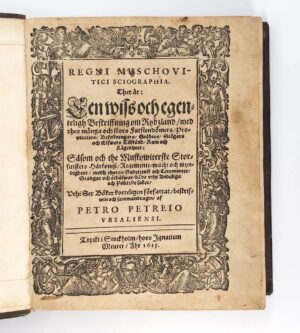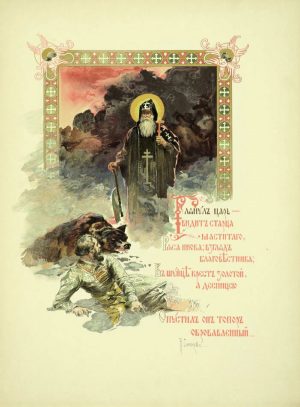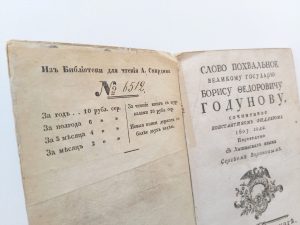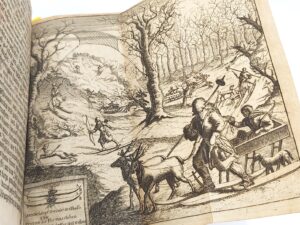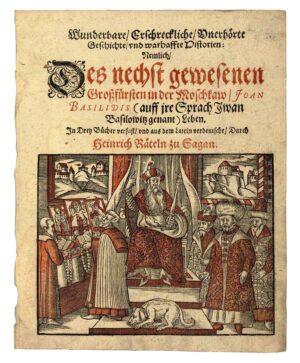Our Notes & References
The Macclesfield copy of this controversial eyewitness account of the Time of Troubles by the first author to suggest in print the Scandinavian origin of the first Russian rulers.
First edition, scarce on the market: we could trace only another copy at auction in recent decades, also in 2008, but in a modern binding.
The Swedish diplomat and envoy in Russia Petrus Petrejus (also Peer Peersson of Erlesunda, 1570-1622) “is rightly considered one of the most remarkable and richest writers about the ancient history and constitution of Russia, since he spent several years in that country at various times and lived there in circumstances that made it easier for him to gather information and news before many others. Particularly important are his contributions to the history of Grand Prince Boris and the False Demetrias, in which he was often able to speak as an eyewitness, as well as his observations on the way of life and the customs and habits of the Russians of his time” (Adelung, our translation here and below).
For four years from 1601 Petrejus lived in Muscovy, gathering information about the country. In 1607-08 he was sent to Russia as an envoy from Charles IX of Sweden to offer Tsar Vasilii Shuiskii a military alliance. Gradually “a prominent figure in the entire Swedish Eastern politics” (Tolstikov), Petrejus came to Russia again in 1611 to meet the alleged son of Ivan the Terrible, now known as False Dmitrii III, who appeared in Ivanogorod and attempted to get military assistance from Charles IX. In his own words, Petrejus, who had seen the first pretender, False Dmitrii I, had to make sure that the new Dmitrii was not the same person.
Having witnessed the famous Russian Time of Troubles [“Smuta”], Petrejus described its most important events on his return to Sweden in this work, his magnum opus, which he dedicated to Gustav II Adolf, the King of Sweden in 1611-32.
Petrejus gives a sketch of Russian history from the foundation of Kievan Rus to 1612, based on various diplomatic materials and earlier works, including Sigismund von Herberstein’s Rerum Moscoviticarum Commentarii and Conrad Bussow’s manuscript of Chronicon Moscoviticum 1584—1613.
“At the same time, the author’s eyewitness account of the events of the Smuta, especially about the circumstances of the Swedish intervention in northern Russia [during the Ingrian War of 1610–17], is extremely important because Petrejus combined in it the awareness of a military agent with the insight of a clever politician” (Shokarev). He additionally gives valuable assessments of the personality and deeds of Ivan the Terrible from the point of view of his Russian contemporaries.
In the book’s second part, Petrejus suggests for the first time that the first Russian kings Riurik, Sineus and Truvor were in fact Swedes. The idea that Scandinavians laid the foundations of the first states of the Eastern Slavs was developed and confirmed by Swedish historiography of the 17th century, and from the 18th century onwards by Russian and European historians. Some Russian scholars however (starting from Mikhail Lomonosov) claim that the Russian state existed before the vocation of Norsemen and even that Riurik was of Slavic descent.
Besides, it is worth noticing that Petrejus’ work, “apart from Heinrich von Staden’s and Giles Fletcher’s testimonies based on false statements, is one of the earliest printed accounts of exile in Siberia” (Shemiakin): “it is so cold in this land that neither grass nor a leaf on a tree grows at all, much less bread or fruit. All those who are in disfavour with the Grand Duke, and who have done something wrong before him, are exiled there; they remain there and lead a miserable life until the Grand Duke again takes them into his favour and allows them to return home.” At that time, sending exiles to Siberia “was not yet widespread and was used by the Moscow government mainly for colonisation purposes” (Shemiakin).
The work is divided into six parts, each with a title and separate pagination, and uses sometimes intricate decorative letterings, while the main title is placed within a lovely historiated woodcut frame.
In 1620 Petrejus published in Leipzig a second edition of his work, this time in his own German translation. Like most early Western accounts of Russia, the work has been criticised for the unfavourable exaggerations about Muscovites and their rulers, and remained forbidden in the Russian empire for a long time. It was finally published there only in 1851, in German – and in 1867 in Russian.
Provenance
Earls of Macclesfield, Shirburn Castle (1860 North Library armorial bookplate in duplicate, one to upper pastedown with old shelfmark writen above, and one to first fly-leaf with shelfmark on bookplate, and blindstamp crest to first leaves; Sotheby’s Macclesfield sales, part XII, 10 Feb. 2008, lot 4663); Pr. Philip Longworth (1933-2020, historian, writer and book collector, esp. on Russian history).
Bibliography
Adelung, Übersicht II, 241; Cat. Russica P-439.
Aleksandr Tolstikov, “Petr Petrei i Shvedskaia propaganda v period smuty” // Smutnoe vremia v Rossii: konflikt i dialog kultur, Trudy istoricheskogo fakulteta Sankt-Peterburgskogo universiteta, #10, 2012.
Shokarev S., “Petr Petrei. Istoriia o velikom kniazhestve moskovskom”, O nachale voin i smut v Moskovii, Fond Sergeia Dubova, 1997.
Shemiakin A. N. “‘Petr Petrei’, 1867”, Sibir v izvestiiakh zapadno-evropeiskikh puteshestvennikov i pisatelei, XIII-XVII vv., Sibirskoe otdelenie Rossiiskoi akademii nauk, Novosibirsk, 2006.
Physical Description
Four parts in a small 4to volume (19 x 16.5 cm). I. Title within historiated woodcut border and with woodcut arms to verso, [10] introduction and dedication, 111 pp. [but actually 113; pagination mistakes]; II. Section title, 274 pp.; III. Section title, 36 pp.; IV. Section title, 15 pp.; V. Section title, 33 pp.; VI. Section title and 50 pp.
Binding
Near contemporary sheep, gilt fillet border, spine gilt in compartments.
Condition
Binding marked and rubbed, spine a bit flaking with small chip at head, label chipped; occasional spotting or (water)staining, mostly marginal, some quires browned due to paper’s poor quality, a handful of lower outer corners torn away in the blank margin, one leaf with tiny hole affecting a letter or two, occasional contemporary ink underlining and annotations, some a bit shaved. Still a solid copy in its first binding, with full margins.



